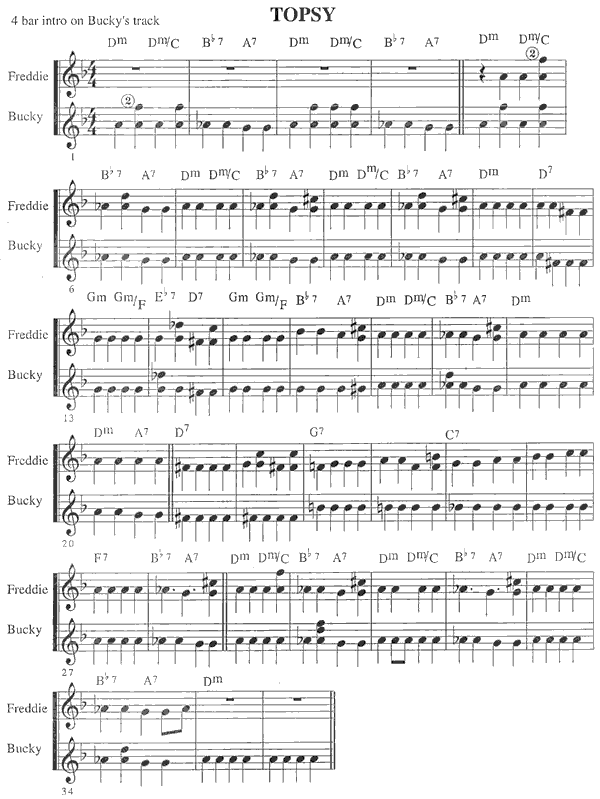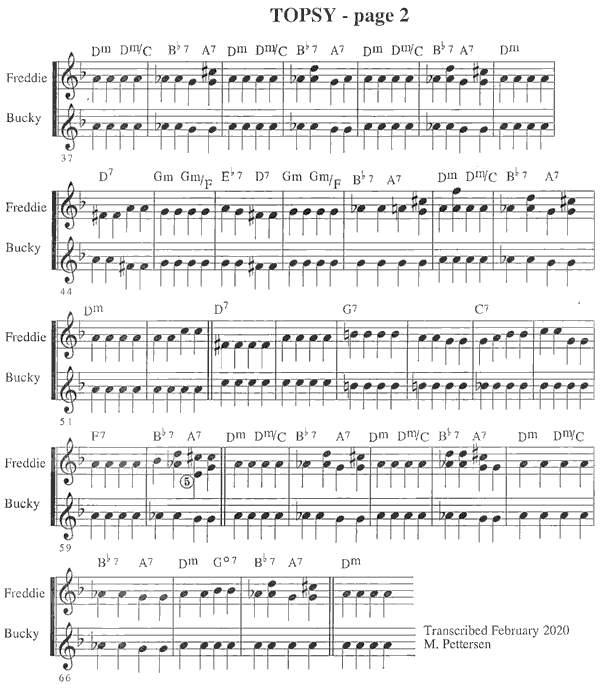
 |
Transcription: TopsyTune: Topsy Tune: Topsy Freddie Green and Bucky Pizzarelli are two guitarists who have inspired swing rhythm players worldwide. This dual transcription compares Freddie's guitar part to Bucky's part. It otters the rare opportunity to study two rhythm guitarists playing the same tune, in the same key, at nearly the same tempo. The recordings were made twelve years apart, yet share the same drummer, Butch Miles. Freddie and Bucky primarily employ one-note chords, with two-note chords added tor variety. The chord progression notated above the staff is from Freddie's recording. Bucky's recording has slight variations of the harmonic progression that is easily heard on the CD. "Topsy" is in the key of D minor. As the fourth (D) string is the mainstay of both player's style, the key restricts the available notes. Fourth string chord tones for a D minor chord are: D (open string), F (third fret), A (seventh fret), and D (twelfth fret). As the lower D is an open string, it is unusable tor rhythm guitar. The upper D is too high in pitch. Its sonority lacks the sonic "heft" required tor a pulsing rhythm. The F and the A are most useful. Freddie and Bucky choose the A whenver there is a D minor chord. While the F could be played, it sounds "muddy" on the fourth string, being the third of the D minor chord. However, the F does work well when played an octave higher on the second string with the A sounding simultaneously on the fourth string. This pairing is first heard in measure 1 of Bucky's part. Note how often Freddie and Bucky choose the same pitches in a measure, confirming the limited note choices available to guitarists employing one-note chords. The art of rhythm guitar lies in creating variation within the available note choices. Unless otherwise stated, the lower notes are played on the fourth (D) string; the upper notes played on the third (G) string. Measure 22 - Freddie plays a G on beat two to create a suspension that resolves to the F# on beat three. Bucky plays F# tor four beats. Measures 25 and 26 - Freddie plays an ascending scale over the C7 chord; Bucky plays a Bb (the seventh of C7 chord) for eight beats. Measure 51 - Freddie anticipates the forthcoming D7 chord by playing a C on beats three and four. Bucky plays A for four beats. Measures 56 and 57 - Freddie again plays an ascending scale over the C7 chord. Bucky plays Bb for eight beats. This "Topsy" transcription does not illustrate how each player varies the precise length of the quarter note pulse. Variations within a measure include: a) long-short-long-short; b)shortshort- long-s hort; c) short-short-short-short; d) short-long-short-long; e) long-shortshort- short. Listening to the recording closly will aid the beginning rhythm guitarist in understanding this concept. In addition, refer to the transcription of "From Coast To Coast" in which each quarter pulse played by Freddie is notated for duration. For instruction on how to play one-note and two-note voicings, see: http://www. freddieg reen .org/technique.html Transcribed by Michael Pettersen, February 2020 

|